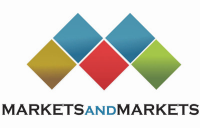Antistatic Agents Market 2019 – Global Market Growth, Size, Share, Trends and Forecasts to 2024

Northrook, IL -- (SBWire) -- 02/27/2020 --The report "Antistatic Agents Market is projected to grow from USD 437 million to USD 594 million by 2024, at a CAGR of 6.3% from 2019 to 2024. The growth of this market can be attributed to the increasing demand for antistatic agents from the packaging, electronics, and textiles industries. The growth of this market can be attributed to the increasing demand for antistatic agents from the packaging, electronics, and textiles industries. Rising population, ongoing urbanization, and increasing disposable income of the middle-class population are the main factors that have led to the growth of packaging, electronics, and textiles industries across the globe. This, in turn, is expected to drive the growth of the antistatic agents market, worldwide.
Download PDF Brochure @ https://www.marketsandmarkets.com/pdfdownloadNew.asp?id=163457499
The packaging segment is projected to lead the antistatic agents market from 2019 to 2024, in terms of volume.
Based on end-use industry, the packaging segment is estimated to account for the largest share of the antistatic agents market in 2019, in terms of volume. Antistatic agents are used to reduce the accumulation of static charge over plastic surfaces during their transportation or stacking. Increasing demand for antistatic agents from the industrial packaging, retail packaging, and consumer packaging sectors have contributed to the growth of the packaging segment of the market.
The ethoxylated fatty acid amines segment is projected to lead the antistatic agents market during the forecast period, in terms of volume.
The ethoxylated fatty acid amines segment is estimated to capture about one-third of the antistatic agents market in 2019, in terms of value. This segment is projected to grow at the highest CAGR during the forecast period, in terms of volume. In comparison to other types of antistatic agents, ethoxylated fatty acid amines offer high processing stability and superior performance benefits, which make them one of the most preferred antistatic agents used in the packaging industry.
Based on form, the liquid segment is projected to lead the antistatic agents market during the forecast period, in terms of value.
The liquid segment is estimated to account for the largest share of the antistatic agents market in 2019, in terms of value. Liquid antistatic agents have a higher tendency to migrate over the material surfaces as compared to other forms of antistatic agents. These agents are used mainly in spraying and efficient dyeing applications. The application of liquid antistatic agents results in non-sticky surfaces and effective antistatic properties, which improve the weaving operations in the textiles industry. These ionic liquids can be transparent or translucent and as such, do not hamper the optical properties of the final products.
Get 10% FREE Customization on this Report @ https://www.marketsandmarkets.com/requestCustomizationNew.asp?id=163457499
The Asia Pacific region is projected to lead the antistatic agents market from 2019 to 2024, in terms of value and volume.
The Asia Pacific region is estimated to account for the largest share of the antistatic agents market in 2019 in terms of value and volume, followed by the European and North American regions. China is one of the major consumers of antistatic agents in the Asia Pacific region. Improving lifestyle of the population, increasing investments in the packaging industry, and flourishing electronics, automotive, and textiles industries in Asia Pacific are fueling the demand for antistatic agents in the region, thereby contributing to the growth of the Asia Pacific antistatic agents market.
Key market players covered in this report include BASF SE (Germany), Arkema (France), Clariant (Switzerland), Croda International PLC. (UK), DowDuPont (US), Evonik Industries AG (Germany), Nouryon (Netherlands), Solvay S.A. (Belgium), PolyOne Corporation (US), Riken Vitamin Co., Ltd. (Japan), Mitsubishi Chemical Corporation (Japan), and Kao Group (Japan).
Recent Developments:
- In October 2017, Clariant launches amide/amine-free anti-static concentrate for clean-room and API films which is used in the production of pharmaceutical products. This innovation was done owing to the stringent government regulation regarding the use of toxic material for producing antistatic agents. This product has helped the company to increase its market by producing a bio friendly product by helping manufacturers in the medical and pharmaceutical sectors control and minimize risk.
- In June 2019, Kao Group's Kao Corporation has expanded its production by completing the joint venture between Kao and PT Apical of Apical Group. This joint venture is done with the view to increase the production capacity of fatty acids which are required to produce antistatic agent. With this the company has able to extend its reach and strengthen their supply chain produce high quality of products for wide range of applications.
In October 2017, BASF SE developed a new product Elastollan® which has high antistatic, mechanical strength, abrasion resistance, a broad hardness range and a good slip resistance which makes it appropriate to be used for the safety shoe sole which can be manufactured with injection molding. This has helped the company to update its PU and TPU product portfolio.
Speak to Analyst @ https://www.marketsandmarkets.com/speaktoanalystNew.asp?id=163457499
Media Relations Contact
Mr. Sanjay Gupta
1-888-600-6441
https://www.marketsandmarkets.com/Market-Reports/antistatic-agent-market-163457499.html
View this press release online at: http://rwire.com/1279752